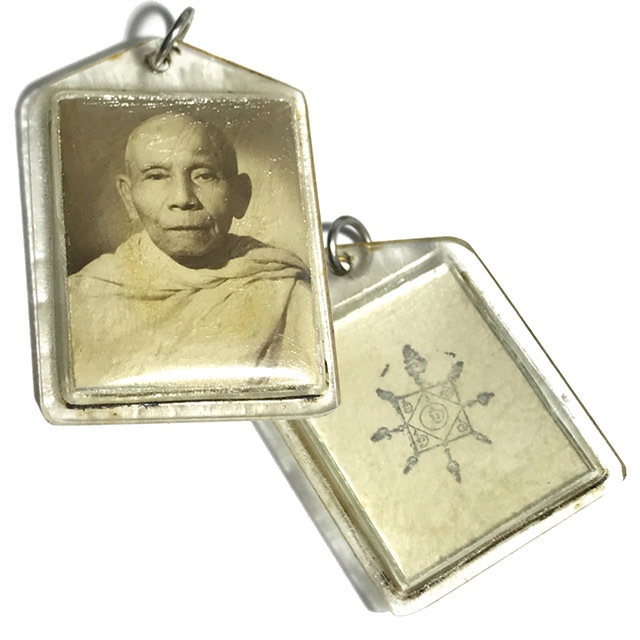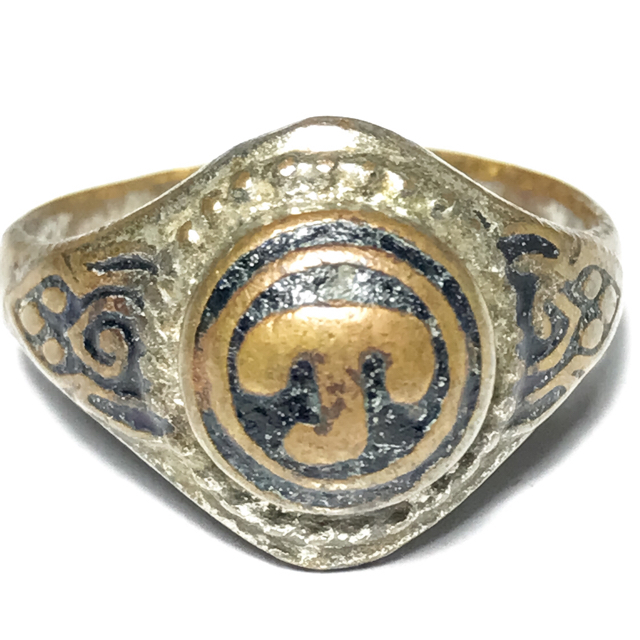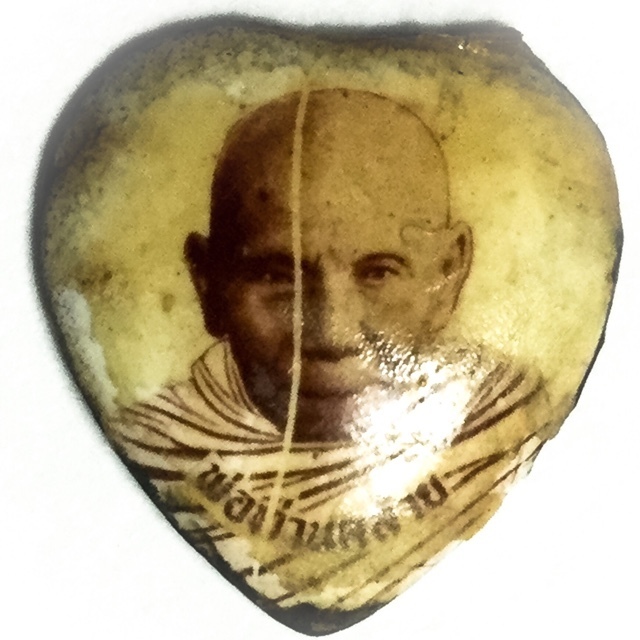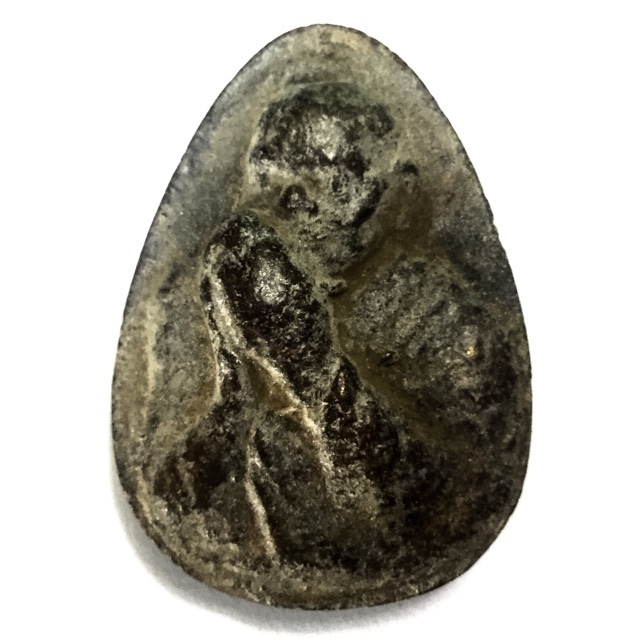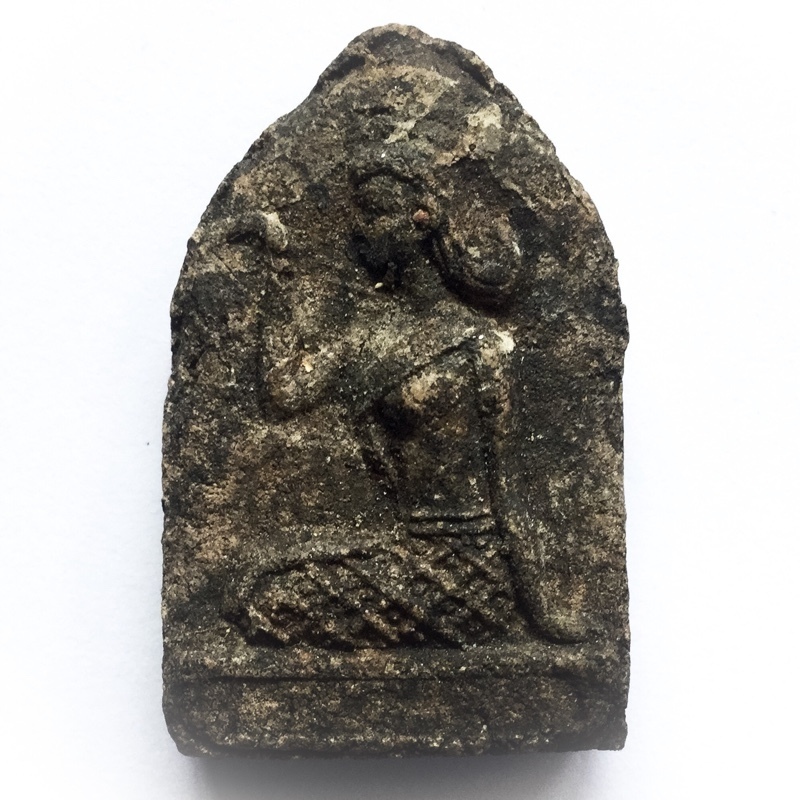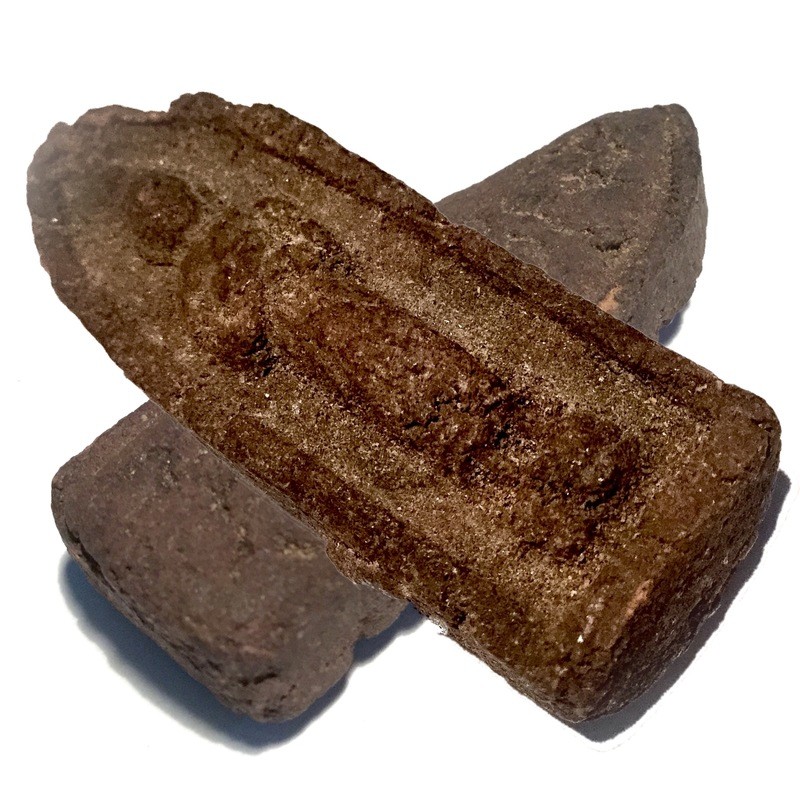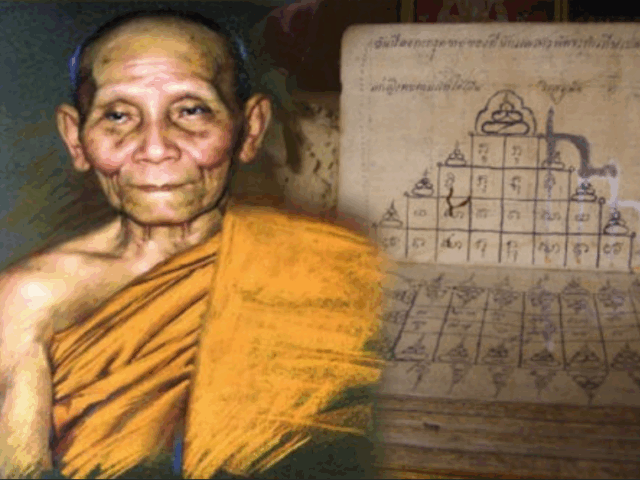
Life and Merits of Por Tan Klai Wajasit of Wat Suan Khan
Introduction: The Life and Reverence of Por Tan Klai
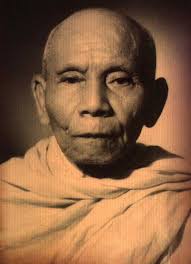
Luang Por Klai Wat Suan Khan (Por Tan Klai)
Por Tan Klai, born Klai Seenil, stands as a towering figure of reverence within Thai Buddhism, particularly in the southern regions of Thailand. Por Tan Klai is widely regarded as one of the foremost Guru Master Monks of the last century, and is esteemed as one of the four great masters of the previous generation belonging to the distinguished Khao Or Southern Sorcery Lineage. This lineage, deeply rooted in Southern Thai traditions, suggests a profound engagement with esoteric practices and spiritual knowledge that contributed significantly to his revered status.
His life journey, from his formative years through his dedicated monastic path, spiritual evolution, and influential leadership, offers a compelling study of devotion and impact within Thai religious history. A defining characteristic of his reputation was the widely acknowledged phenomenon of his “truthful speech,” known as Wajasit, which often manifested in predictions that came to pass, earning him the esteemed title of “Golden Mouth Monk”.
This remarkable ability played a crucial role in shaping the faith and respeoct he garnered from his followers and the broader community. His earthly journey culminated in his passing in 1970, after which his mortal remains were enshrined in a glass coffin at Wat That Noi, the temple that became his residence from 1957. This enshrinement transformed Wat That Noi into a significant site of pilgrimage, a testament to his enduring legacy and the unwavering devotion he continues to inspire. The narrative of Por Tan Klai’s life is one that intertwines personal resilience with profound spiritual attainment, leaving an indelible mark on the landscape of Thai Buddhism.
Early Life and Influences (1876-1891)
Klai Seenil entered the world on March 27, 1876, in the province of Nakhon Si Thammarat, nestled in the southern part of Thailand. According to the Thai lunar calendar, his birth occurred on the fifteenth day of the fourth lunar month of the Year of the Rat. This year, 1876, corresponded with the Year of the Rat in the Chinese zodiac, a system often observed in conjunction with the Thai lunar calendar. Nakhon Si Thammarat boasts a long and distinguished history, recognized as one of Thailand’s most ancient cities with a particularly strong foundation in Theravada Buddhism, largely influenced by traditions originating from Sri Lanka. The Year of the Rat, within Thai cultural beliefs shaped by Chinese astrology, is often associated with traits such as intelligence, agility, and an inclination towards wealth, although some perspectives might also foresee potential challenges during this zodiac year. Furthermore, the fifteenth day of the lunar month holds particular significance in Buddhism as it typically marks the full moon, a time considered sacred for religious observances.
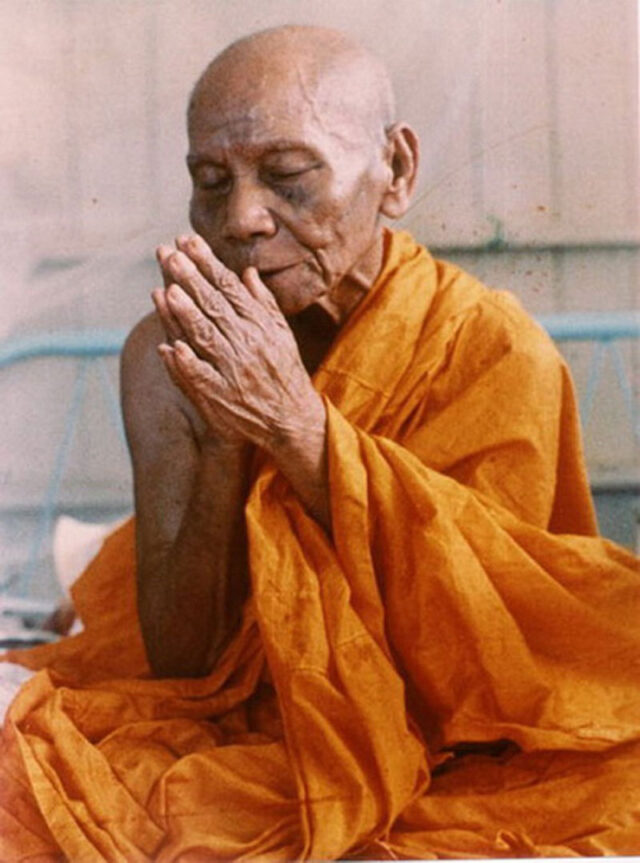
His parents, Mr. In and Mrs. Niew Seenil, along with his elder sister, Nang Peng, formed the immediate family unit that would shape his early experiences. Traditional Thai society places a strong emphasis on familial relationships, respect for elders, and the early inculcation of virtues like diligence, obedience, and a gentle nature. Within this cultural context, the influence of his parents and his relationship with his elder sister likely played a crucial role in the development of his foundational character. The values of diligence, obedience, a gentle disposition, and a respectful demeanor, which were noted as inherent to him, align closely with the traditional Thai virtues instilled from childhood. These qualities, nurtured within the family and the broader cultural environment of the time, would have served as a strong moral compass throughout his life and likely contributed to the high regard he later held within the monastic order and the wider community. Such virtues are often viewed as indicative of a person with a strong moral foundation, predisposed towards spiritual growth and respected within the community.
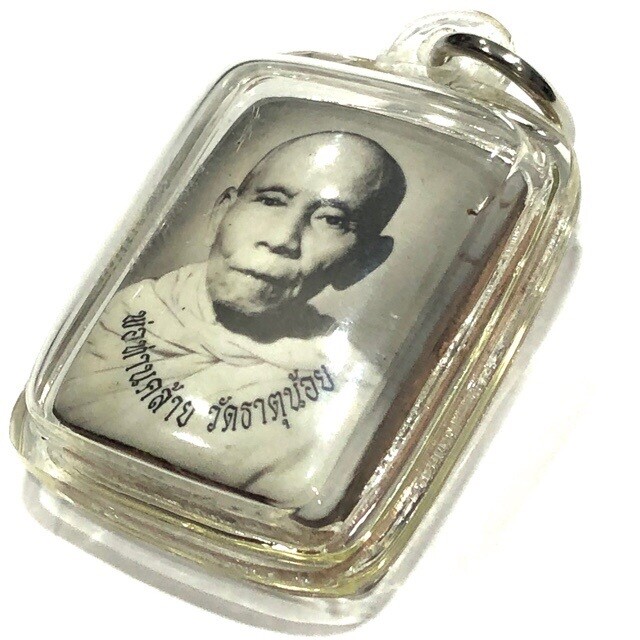
Por Tan Klai is most highly revered in the South of Thailand as one of the Great Khao Or Masters of the Dtamnak Dtak Sila Khao Or Sorcery School Lineage, but gained Devotees on a National scale due to the fact he was often called upon to attend blessing ceremonies around the country, and for the many stories of miracles associated with his amulets which have occurred over the decades.
The Turning Point: Adolescence and Resilience (1891)
At the age of fifteen, around the year 1891, a significant event occurred that would profoundly impact the trajectory of young Klai Seenil’s life. While engaged in the arduous task of forest clearing, a severe accident took place when a tree unexpectedly fell, resulting in a shattering injury to his left leg, specifically fracturing three toe . The injury was so debilitating that it severely impaired his ability to walk, necessitating the assistance of his water buffalo for mobility. This reliance on an animal for basic movement highlights the significant physical challenge he faced during his adolescence.
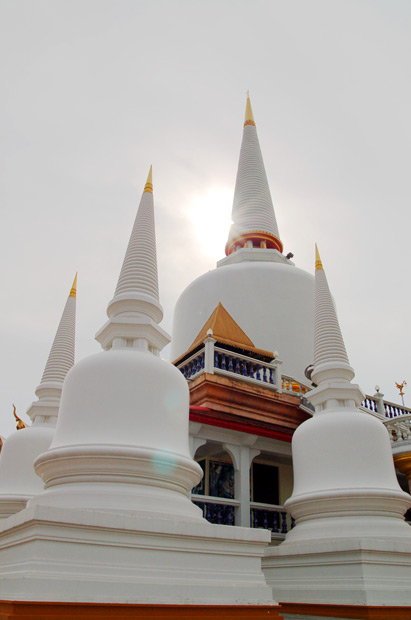
In the late 19th century, access to modern medical care in rural Thailand, particularly in provinces like Nakhon Si Thammarat, was extremely limited, with most medical facilities and practitioners concentrated in the capital city of Bangkok. Consequently, for severe injuries sustained in rural areas, traditional remedies and self-reliance often represented the only available options. Faced with the absence of adequate medical intervention for his shattered toes, Por Tan Klai made the difficult and courageous decision to self-administer amputation of the affected digits.
This act, while undoubtedly painful and carrying significant risks of infection, underscores an extraordinary level of self-reliance, resilience, and remarkable fortitude. In a time where modern medical assistance was scarce, this decisive action was likely crucial in preventing further complications and ultimately preserving his ability to move. This pivotal moment in his young life served as a powerful early indication of his inherent strength and unwavering perseverance in the face of substantial adversity, foreshadowing the many challenges he would overcome throughout his life’s journey.
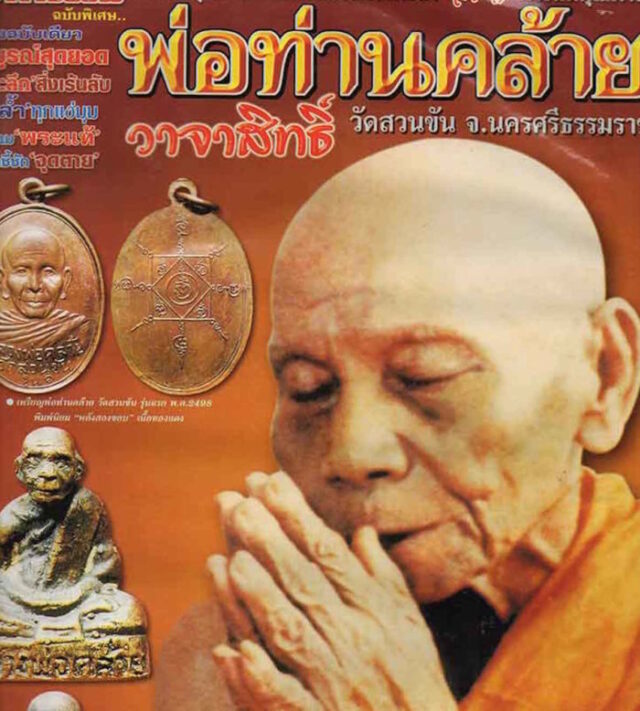
Embracing Monastic Life (1895-1896)
At the age of nineteen, around the year 1895, Klai Seenil embarked on a significant spiritual path by entering monastic life. His novice ordination took place on June 30, 1895, at Wat Chandi under the guidance of Phra Athikarn Chan. Choosing to enter the Sangha, the Buddhist monastic community, is a profound decision for many Thai men, often viewed as a path towards spiritual merit, scholarly pursuits, and contributing to the preservation of Buddhist teachings. Wat Chandi, as a local temple in Nakhon Si Thammarat, would have served as a central hub for religious practices and the dissemination of Buddhist knowledge within the community. His decision to ordain as a novice at a relatively young age, particularly after enduring the physical hardship of his earlier accident, suggests a growing inclination towards spiritual contemplation and a commitment to the tenets of Buddhism. The mentorship of Phra Athikarn Chan at Wat Chandi would have marked his initial formal training in the monastic discipline and Buddhist principles.
Demonstrating a remarkable dedication to the monastic code from the outset, the young novice committed himself to the precise memorization of the Patimokkha. The Patimokkha comprises a fundamental set of monastic rules, forming part of the broader Vinaya, which govern the conduct of monks and novices. The meticulous memorization of these rules signifies a serious commitment to the ethical framework of monastic life and the foundational principles of Buddhist practice. This early display of diligence and adherence to monastic discipline likely played a crucial role in his subsequent spiritual development and the respect he earned within the monastic community.
A year later, at the age of twenty, around 1896, he underwent the higher ordination, becoming a fully ordained Bhikkhu at the temple boundary stone. During this significant ceremony, he received the monastic name “Chantasuwanno” from Phra Khru Karai Kongkasuwanno, the abbot of Wat Had Suang. Full ordination represents a deeper level of commitment within the monastic order, entailing a more extensive set of rules and responsibilities.
The Temple boundary monument stone ordination practice, is traditionally a designated sacred space used for performing a certain part of ordination ceremonies. Receiving a new monastic name from a senior, respected monk like the abbot of Wat Had Suang is a customary and significant aspect of the ordination ritual, symbolizing the initiate’s formal entry into the higher ranks of the Sangha and the beginning of more advanced spiritual training under the guidance of established monastic figures.
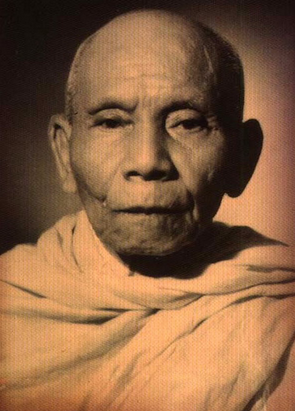
Por Tan Klai’s Monastic Milestones
1895 |age 19; Received Novice Ordination at Wat Chandi from Phra Athikarn Chan
1896 at age 20 he received Full Ordination (received name “Chantasuwanno”) Uthakukhepa Sima , and the title of ‘Phra Khru Karai Kongkasuwanno’, Abbot of Wat Had Suang.
1902 Age 26 he was Appointed Abbot of Wat Suan Khan
1955 age 79 Por Tan Klai Received title “Phra Khru Sanya Bhat”
19[User Query357 age 81 Became Abbot of Wat That Noi
Education and Intellectual Development
Prior to fully embracing monastic life, Por Tan Klai received his initial education within the familiar surroundings of his family home. Under the tutelage of his father, he gained foundational knowledge in arithmetic and was introduced to ancient scripts. In the late 19th century, before the widespread establishment of formal schooling in rural Thailand, basic literacy and numeracy were often imparted within the family unit, particularly to male children who might later pursue religious studies. The learning of ancient scripts, which would likely have included the Thai script and potentially extended to Pali or Khmer, would have provided him with essential tools for engaging with religious texts and furthering his education within a monastic setting. This early educational foundation laid by his father provided him with a crucial intellectual groundwork before he formally entered the monastic order.
Following his initial learning at home, Por Tan Klai continued his studies at the monastery of Nai Kam, located at Wat Thung Pon. For centuries, monasteries in Thailand served as the primary centers of learning, offering instruction not only in religious doctrines and scriptures but also in subjects like reading, writing, and other traditional knowledge. Studying under a specific monk, such as Nai Kam, suggests a more focused and potentially advanced level of instruction and a mentorship relationship. While the provided research does not offer specific details about Wat Thung Pon or the monk Nai Kam, the practice of monks providing education within monasteries was a well-established tradition. This period of study at Wat Thung Pon would have been instrumental in deepening his understanding of Buddhist principles and expanding his intellectual horizons within the monastic framework.
A testament to his intellectual dedication, Por Tan Klai achieved mastery in both the Thai and Khmer scripts. Proficiency in these scripts was a significant intellectual accomplishment during that era. The Khmer script held particular importance as it was often used for writing Pali, the sacred language of Theravada Buddhism, and also carried historical and cultural significance in Southeast Asia. His command of both scripts demonstrates a strong commitment to accessing and understanding religious knowledge in its original forms, a skill that would have been invaluable for his in-depth study of Buddhist texts and his later role as a respected teacher and scholar.
Further broadening his intellectual and experiential landscape, Por Tan Klai engaged with the traditional Thai shadow puppetry known as “Nang Talung” under the guidance of Nai Thong Sak. Nang Talung is a cherished and ancient form of folk entertainment prevalent in Southern Thailand, serving not only as a source of amusement but also as a medium for storytelling, cultural preservation, and often incorporating moral and religious themes. The art of Nang Talung demands a diverse set of skills, including the manipulation of puppets, vocal dexterity for narrating and portraying different characters, improvisational abilities, and the capacity to engage and captivate an audience. His involvement in this traditional art form under the tutelage of Nai Thong Sak likely played a significant role in shaping his public persona and honing his oratory skills. The experience of performing Nang Talung would have provided him with valuable practice in captivating audiences, effectively conveying narratives, and potentially weaving in moral and religious lessons into his presentations, skills that would have proven highly beneficial in his later role as an influential monk and teacher within his community.
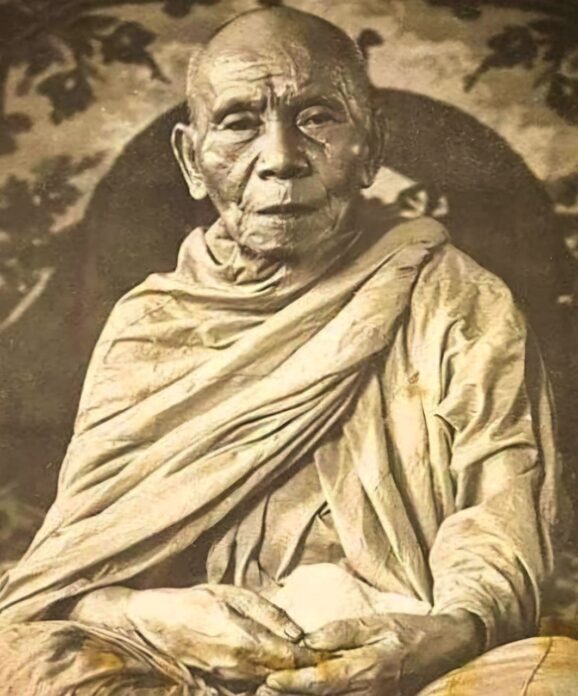
Spiritual Growth and Meditation
As Por Tan Klai progressed in his monastic life, he dedicated himself to a deep immersion in the fundamental principles of Buddhism. He focused intently on the study of Buddhist scriptures, seeking a comprehensive understanding of the Buddha’s teachings. Simultaneously, he adhered diligently to the Vinaya, the monastic code of conduct, which provides the ethical and disciplinary framework for monastic life. This commitment to both the intellectual and practical aspects of Buddhist doctrine formed the bedrock of his spiritual development.
Seeking to further his understanding of the sacred texts, Por Tan Klai pursued advanced studies in the Pali language at the esteemed Wat Phra Boromathat. His tutelage came under the guidance of Phra Khru Kaew (Sri). Wat Phra Boromathat in Nakhon Si Thammarat stands as a highly revered temple, recognized as one of the most significant Buddhist sites in Southern Thailand, with a rich history deeply intertwined with Theravada Buddhism and influences from Sri Lankan traditions.
The title “Phra Khru” denotes a respected rank within the monastic hierarchy, indicating Phra Khru Kaew (Sri)’s own scholarly achievements and standing. Studying Pali, the original language of the Theravada Buddhist scriptures, at such a prestigious center of learning under the guidance of a respected teacher would have provided Por Tan Klai with a profound and nuanced understanding of Buddhist philosophy and practice. This in-depth engagement with the scriptures in their original language would have undoubtedly deepened his spiritual insights and strengthened his foundation in Buddhist doctrine.
In his quest for deeper spiritual realization, Por Tan Klai also explored the practice of Vipassana meditation. He sought guidance at the Samphan Monastery, located in Surat Thani, where he studied under the direction of Phra Nu. Vipassana meditation, often translated as “insight meditation,” is a core Buddhist practice focused on cultivating mindfulness and developing profound insight into the impermanent and interconnected nature of reality. Surat Thani, a province situated in Southern Thailand, has a notable history of meditative practices and later became the site of Suan Mokkh, a renowned forest monastery founded by Buddhadasa Bhikkhu, known for its emphasis on meditation. While further research would be needed to establish the specific history and lineage of Samphan Monastery and Phra Nu, Por Tan Klai’s engagement with Vipassana meditation indicates a significant commitment to personal spiritual development through direct meditative experience. This exploration of Vipassana likely contributed to his own deepening spiritual insights and potentially equipped him with the skills and understanding necessary to guide others in the practice of meditation, ultimately leading to his recognition as a respected meditation teacher.
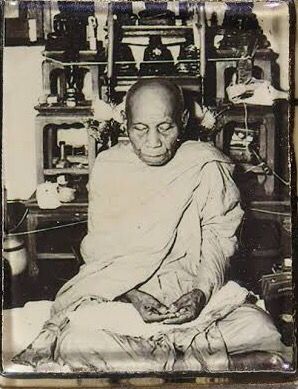
Leadership and Community Influence
Por Tan Klai’s dedication and spiritual growth led him to assume significant leadership roles within the monastic community. In 1902, at the age of twenty-six, he was appointed as the abbot of Wat Suan Khan. Assuming the position of abbot is a role of considerable responsibility within a Thai Buddhist temple. The abbot serves as the administrative head, provides spiritual guidance to the resident monks, and acts as a central figure in the relationship between the temple and the local lay community 1. His relatively young age at the time of his appointment suggests that he had already demonstrated strong leadership potential, spiritual maturity, and had earned the respect of his fellow monks and the wider community. His tenure as abbot of Wat Suan Khan likely marked the beginning of his significant influence and service to the local population. His leadership at Wat Suan Khan was characterized by compassion and a strong focus on the needs of the community. Furthermore, he actively promoted education within the monastery and likely extended his efforts to support learning within the broader community, reflecting the traditional role of temples as centers of education in Thai society.
In recognition of his long-standing service and significant contributions to Buddhism, Por Tan Klai received the esteemed honorific title of “Phra Khru Sanya Bhat” in 1955. The title “Phra Khru” is a rank within the Thai Sangha, the council of monks, conferred upon monks who have demonstrated exceptional service and made valuable contributions to the propagation and preservation of Buddhist teachings 80. While the specific meaning and historical context of the suffix “Sanya Bhat” within this title would require further specialized research into the intricacies of the Thai monastic hierarchy and its evolution, the conferral of such a title undoubtedly signifies a high level of respect and official recognition from the governing body of the Thai monastic order. This honor further elevated his standing and authority, both within the monastic community and in the eyes of the laypeople who revered him.
Subsequently, in 1957, at the age of eighty-one, Por Tan Klai became the abbot of the newly established Wat That Noi. The establishment of a new temple is a significant undertaking, and his appointment as its first abbot indicates the high regard in which he was held and the trust placed in his ability to lead and develop this new religious center. Under his guidance, Wat That Noi flourished, becoming a focal point for the local community and a testament to his spiritual leadership. While the provided research does not explicitly detail his core teachings, his life of dedicated monastic practice, his emphasis on study and meditation, and his compassionate leadership style suggest that the fundamental tenets of his teachings likely revolved around ethical conduct, the practice of meditation, and the cultivation of wisdom, aligning with core Buddhist principles.
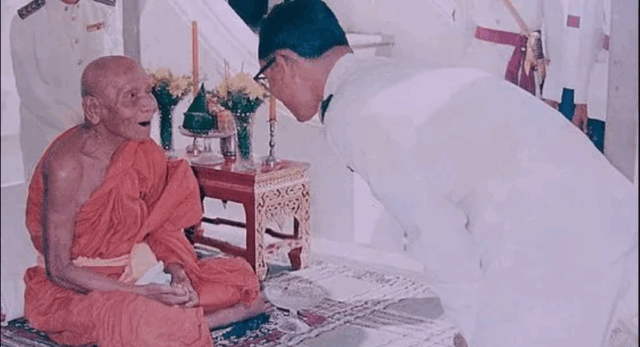
The Power of “Truthful Speech” and Sacred Objects
A distinctive aspect of Por Tan Klai’s life and the profound reverence he commanded was the widely acknowledged phenomenon of his “truthful speech,” or Wajasit. It was a common belief among his followers and the wider community that whatever Por Tan Klai said or predicted often came to fruition. This reputation for the accuracy of his pronouncements earned him the revered title of “Golden Mouth Monk,” signifying the perceived power and efficacy of his words. This belief fostered immense respect and a deep sense of faith in him, with people often seeking his counsel and taking his words as having a special, almost prophetic weight.
Associated with Por Tan Klai are numerous narratives of miraculous events and the presence of sacred objects believed to possess special powers due to his blessings and spiritual influence. These objects include amulets, yantras (sacred geometric designs inscribed on various materials), and holy water. Amulets blessed by Por Tan Klai are particularly rare and highly prized by devotees, often linked to the powerful Khao Or lineage and believed to offer protection and bring good fortune. Yantras, imbued with sacred power through his consecration, were also likely revered for their protective qualities. Holy water, often blessed through specific rituals and the monk’s spiritual energy, is a common element in Thai Buddhist practices, believed to possess healing and auspicious properties.
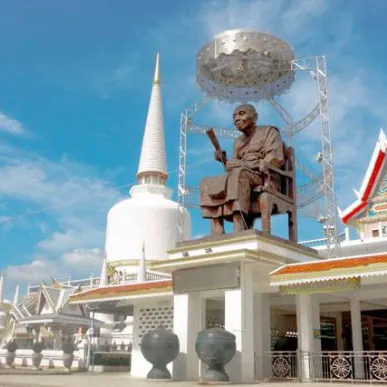
The user query mentions an anecdote of Ekachai’s survival in a car accident in 1907. While the provided research snippets yielded information about contemporary individuals named Ekachai involved in various incidents, no direct textual evidence was found to corroborate this specific anecdote with Por Tan Klai and a car accident in 1907. Given the time period, car accidents would have been exceedingly rare in Thailand. It is possible this anecdote is part of the local oral tradition surrounding Por Tan Klai, where stories of miraculous protection and the power of revered monks often circulate and evolve over time. The specific details, including the name and date, might not be historically verifiable through the provided sources.
Regarding his teachings on occult practices, the query suggests that Por Tan Klai emphasized the importance of wisdom over superstition in discerning such matters. Further research beyond the provided snippets would be necessary to fully elaborate on the specifics of his teachings in this area. However, it can be inferred that a highly respected monk like Por Tan Klai would likely guide his followers towards a balanced perspective, encouraging critical thinking and genuine understanding rather than blind faith in unsubstantiated beliefs.
Legacy and Enduring Reverence
Por Tan Klai’s life journey, marked by profound spiritual dedication and significant community impact, left an enduring legacy within Thai Buddhism. He passed away on December 5, 1970, at the venerable age of ninety-four. Following his passing, his mortal remains were enshrined at Wat That Noi, the temple where he spent his final years as abbot. This enshrinement transformed Wat That Noi into a significant pilgrimage site, drawing devotees from far and wide to pay their respects to the revered monk. Notably, it is reported that Por Tan Klai’s body did not undergo the natural process of decay after his death 3. This phenomenon is often interpreted within Buddhist traditions as a sign of exceptional spiritual purity and elevates the status of the deceased monk to that of a saintly figure, further enhancing the reverence he commands.
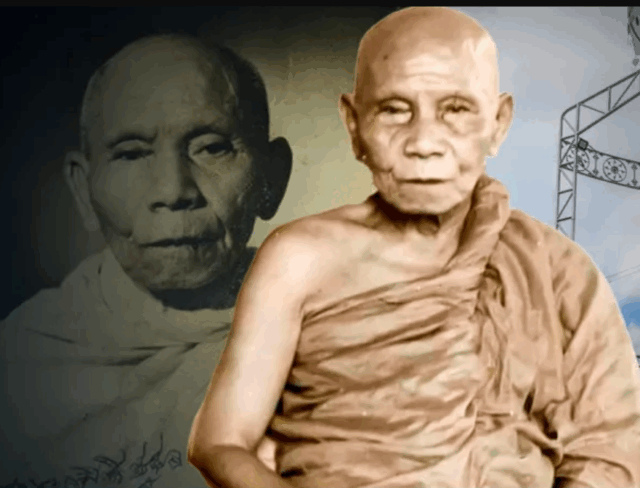 o
o
His lasting impact on Thai Buddhism is undeniable. His deep spiritual practice, his compassionate and community-focused leadership, the widely acknowledged power of his “truthful speech,” and the numerous narratives of miraculous events associated with him have all contributed to his enduring legacy. His significant connection to the prestigious Khao Or Southern Sorcery Lineage further solidifies his important place within a distinct and influential tradition of Southern Thai Buddhism.
Even in contemporary Thai society, Por Tan Klai continues to be revered as a saintly figure, his name and image evoking deep respect and faith among a vast number of people. While the specifics of his teachings on truthfulness, compassion, and spiritual wisdom require further exploration, his life itself, characterized by unwavering dedication to monastic principles, selfless service to his community, and a powerful reputation for spiritual insight, serves as a potent embodiment of these core Buddhist values, ensuring the enduring relevance of his example in the modern world. His biography stands as a powerful testament to a life lived with profound purpose, unwavering integrity, and deep devotion to the principles of Buddhism.
A Life of Profound Purpose and Devotion
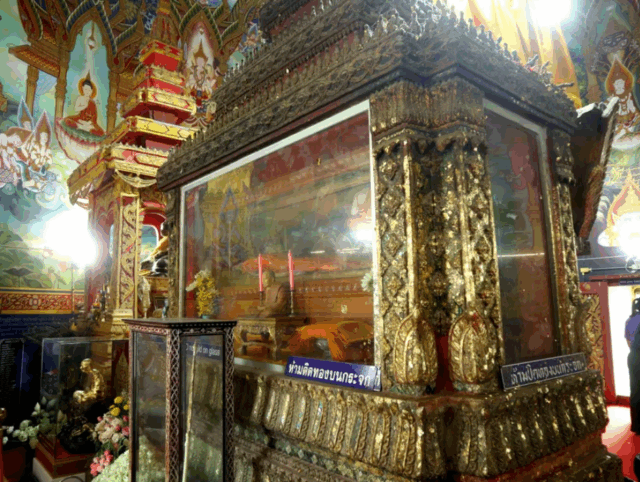
The life of Por Tan Klai, born Klai Seenil, reveals a remarkable journey of spiritual dedication and profound impact. From his early years in Nakhon Si Thammarat, marked by both familial nurturing and the significant physical challenge of adolescence, he embarked on a monastic path that would lead him to become one of the most revered guru monks in Thai history. His intellectual pursuits, including the mastery of ancient scripts and the deep study of Pali, laid a strong foundation for his spiritual growth. His exploration of Vipassana meditation further deepened his inner understanding and prepared him for his role as a spiritual guide. As abbot of Wat Suan Khan and later the newly established Wat That Noi, he demonstrated compassionate leadership and fostered community well-being. The unique phenomenon of his “truthful speech” and the associated narratives of miracles solidified his legendary status and the deep faith placed in him by his followers. His passing and the subsequent enshrinement of his body at Wat That Noi transformed the temple into a lasting site of pilgrimage, a testament to his enduring reverence. Por Tan Klai’s life exemplifies the core tenets of Buddhism – ethical conduct, meditation, and wisdom – and his legacy continues to inspire countless individuals in their own spiritual journeys. His story serves as a powerful reminder of the transformative potential of a life dedicated to spiritual principles and selfless service.
Works cited
Kata Bucha Por Tan Klai – Thailand Amulets, accessed March 24, 2025,


